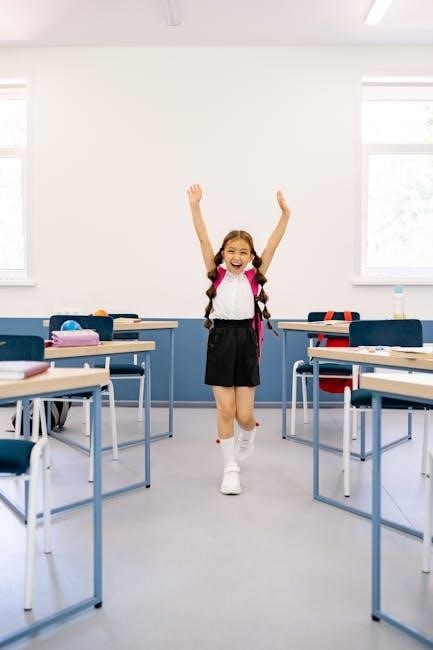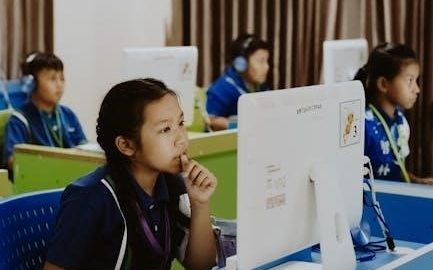Student engagement strategies are essential for fostering active learning, collaboration, and motivation in educational settings. These approaches enhance participation, critical thinking, and overall academic success for students of all ages.
1.1 Defining Student Engagement
Student engagement refers to the degree of participation, interaction, and motivation students exhibit in educational activities. It encompasses emotional, behavioral, and cognitive dimensions, reflecting how students connect with learning content and environments. Engagement is not merely physical presence but involves active involvement, such as contributing ideas, solving problems, and reflecting on material. High engagement fosters deeper understanding, critical thinking, and improved academic outcomes. It is shaped by factors like teacher support, peer interactions, and meaningful tasks, creating a dynamic interplay between the learner and their surroundings. A clear understanding of engagement is crucial for designing strategies that promote meaningful learning experiences and academic success.
1.2 The Importance of Student Engagement
Student engagement is critical for academic success, as it directly influences learning outcomes, motivation, and overall educational development. Engaged students demonstrate higher levels of participation, critical thinking, and creativity, leading to improved performance and satisfaction. It fosters a sense of belonging and accountability, reducing dropout rates and enhancing persistence. Engagement also promotes the development of essential skills, such as problem-solving and collaboration, which are vital for future success. By prioritizing engagement, educators can create meaningful learning experiences that cater to diverse student needs, ensuring a supportive and inclusive environment that encourages growth and achievement. Thus, fostering engagement is a cornerstone of effective education, benefiting both individuals and society.

Active Learning Techniques
Active learning techniques, such as Think-Pair-Share and group discussions, encourage student collaboration and hands-on participation, enhancing engagement and critical thinking in educational settings effectively.
2.1 Think-Pair-Share Method
The Think-Pair-Share method is a widely used active learning technique that promotes student engagement and collaboration. It involves three steps: students first think individually about a question or problem, then discuss their thoughts with a partner, and finally share their conclusions with the entire class. This approach encourages participation from all students, including those who may be hesitant to speak in larger groups. By fostering peer discussion, it enhances critical thinking, clarifies concepts, and builds confidence. Teachers can use this method to assess understanding and adapt instruction accordingly. Its simplicity and effectiveness make it a popular strategy for creating an interactive and inclusive learning environment. This method is particularly effective in diverse classrooms, ensuring every student has a voice and an opportunity to learn from others.
2.2 Group Discussions and Collaborative Learning
Group discussions and collaborative learning are powerful strategies to enhance student engagement by fostering active participation and teamwork. These methods encourage students to share ideas, listen to diverse perspectives, and work collectively toward common goals. Interactive platforms and structured activities facilitate meaningful interactions, while collaborative tasks promote problem-solving and communication skills. Such approaches not only deepen understanding but also cultivate a sense of responsibility among students, as they contribute to shared outcomes. Teachers can use these strategies to create a dynamic and inclusive learning environment, ensuring all students feel valued and motivated to succeed. Collaborative learning also prepares students for real-world scenarios, where teamwork and adaptability are essential. By integrating group discussions, educators can foster engagement, creativity, and critical thinking while encouraging students to take ownership of their learning journey. This approach is particularly effective in fostering a growth mindset and building interpersonal skills.
Classroom Management for Engagement
Classroom management for engagement involves organizing the environment, setting clear routines, and fostering a respectful atmosphere to maximize student focus and participation in learning activities.
3.1 Organizing the Classroom Environment
Organizing the classroom environment is crucial for promoting student engagement. A well-structured space with clear seating arrangements and accessible resources encourages focus and collaboration. Establishing defined zones for different activities, such as group work or quiet reading, helps students understand expectations. Clutter-free areas reduce distractions, fostering a conducive learning atmosphere. Teachers should also ensure that materials are easily accessible, minimizing wasted time. Visual reminders of classroom routines and expectations, such as charts or schedules, reinforce structure. A thoughtfully organized environment creates a respectful and inclusive space, enabling students to concentrate and participate actively in learning activities. This setup supports both academic success and social development, making it a cornerstone of effective classroom management.
3.2 Setting Clear Expectations and Routines
Setting clear expectations and routines is vital for maintaining a structured and engaging classroom environment. Establishing consistent procedures for daily tasks, such as entering the classroom or submitting assignments, helps students feel secure and focused. Teachers should communicate these expectations clearly from the start, ensuring students understand their roles and responsibilities. Routines for transitions, group work, and individual activities minimize disruptions and maximize learning time. Positive reinforcement, such as acknowledging adherence to expectations, encourages responsible behavior. By aligning routines with learning goals, teachers create an environment where students can thrive academically and socially. Clear expectations also foster accountability and mutual respect, laying the foundation for a productive and engaged learning community.
Technology Integration in Learning
Technology integration enhances student engagement by providing interactive and personalized learning experiences, fostering collaboration through digital tools and platforms, and promoting 21st-century skills development effectively.
4.1 Utilizing Educational Software
Educational software plays a pivotal role in enhancing student engagement by providing interactive and personalized learning experiences. These tools offer dynamic content, simulations, and real-time feedback, making complex concepts more accessible. By incorporating multimedia elements like videos and quizzes, educational software caters to diverse learning styles, increasing student motivation. Additionally, many platforms support collaborative features, enabling students to work together on projects and share ideas. The use of gamification elements, such as badges and leaderboards, further boosts participation and friendly competition. Overall, educational software not only enriches the learning process but also prepares students for the digital age, fostering essential skills in technology and critical thinking.
4.2 Implementing Online Learning Platforms
Online learning platforms have emerged as powerful tools for enhancing student engagement, offering flexible and accessible learning environments. These platforms provide a centralized space for course materials, interactive activities, and real-time communication, fostering connectivity among students and educators. Features like discussion forums, live chats, and collaborative projects encourage active participation and peer-to-peer learning. Additionally, platforms often include analytics that track student progress, allowing educators to identify areas where students may need extra support. By leveraging these platforms, educators can create personalized learning experiences that cater to individual needs, ultimately promoting higher levels of engagement and academic success. This approach is particularly effective in both traditional and virtual classrooms, ensuring continuous learning opportunities for all students.
Assessment and Feedback Methods
Assessment and feedback methods are crucial for evaluating student progress, providing insights, and guiding instruction to meet diverse learning needs and enhance overall academic outcomes effectively.
5.1 Formative Assessments for Continuous Improvement
Formative assessments are essential tools for monitoring student progress and providing timely feedback, enabling continuous improvement. These assessments, such as quizzes, exit tickets, and class discussions, allow teachers to identify gaps in understanding and adjust instruction accordingly. By incorporating technology, like educational software, teachers can track engagement and learning outcomes more effectively. Regular feedback loops ensure students stay motivated and guided throughout their learning journey. This approach fosters a growth mindset, encouraging active participation and higher academic achievement. Implementing formative assessments creates a dynamic and responsive learning environment, tailored to meet the diverse needs of all students.
5.2 The Role of Peer and Self-Assessment
Peer and self-assessment strategies empower students to take ownership of their learning, fostering engagement and reflective thinking. These methods encourage students to evaluate their own work and that of their peers, promoting critical thinking and collaboration. By involving students in the assessment process, educators can enhance motivation and accountability. Self-assessment helps students identify strengths and areas for improvement, while peer review provides diverse perspectives and constructive feedback. These practices not only deepen understanding of the material but also develop essential skills like communication and self-reflection. Integrating these strategies into the classroom creates a supportive environment where students actively participate in their learning journey, leading to greater academic confidence and success.
Inquiry-Based Learning Approaches
Inquiry-based learning fosters engagement by encouraging students to explore questions and solve problems through critical thinking and investigation. This method enhances motivation and deepens understanding, making learning meaningful and relevant.
6.1 Problem-Solving Activities
Problem-solving activities are a cornerstone of inquiry-based learning, engaging students by presenting real-world challenges that require critical thinking and creativity. These activities encourage students to explore complex questions, analyze data, and develop innovative solutions. By integrating practical tasks, educators foster collaboration, as students often work in groups to brainstorm and implement ideas. Such activities not only enhance academic skills but also build resilience and adaptability. For example, case studies, project-based learning, and interactive simulations are effective tools for promoting deeper understanding. When students are empowered to tackle meaningful problems, they become more invested in their learning, leading to higher engagement and improved outcomes. These strategies also prepare students for future challenges, equipping them with essential problem-solving skills.
6.2 Guided and Open Inquiry Methods
Guided and open inquiry methods are powerful tools for fostering student engagement by encouraging exploration and discovery. Guided inquiry provides structured frameworks, helping students navigate complex topics through scaffolded questions and resources. Open inquiry, on the other hand, allows students to explore freely, defining their own questions and solutions. Both methods promote critical thinking, creativity, and deeper understanding. Educators can integrate these approaches through projects, debates, or research tasks, enabling students to take ownership of their learning. These methods not only enhance academic skills but also cultivate independence and curiosity. By balancing structure and freedom, inquiry-based learning engages students and prepares them for real-world challenges, where problem-solving and adaptability are essential. These strategies are particularly effective in fostering a love for lifelong learning.

Cultural Responsiveness in the Classroom
Cultural responsiveness in the classroom involves incorporating diverse materials, fostering inclusive practices, and promoting mutual respect among students from varied backgrounds and perspectives.
7.1 Culturally Responsive Teaching Practices
Culturally responsive teaching practices involve tailoring instruction to reflect students’ diverse backgrounds and experiences. This includes using inclusive materials, acknowledging cultural differences, and creating a respectful learning environment. Teachers should incorporate diverse perspectives into the curriculum to ensure all students feel represented. By doing so, they foster a sense of belonging and engagement. Additionally, educators should encourage open dialogue about cultural differences, promoting empathy and understanding. These practices not only enhance academic performance but also contribute to students’ social and emotional development. By embracing cultural responsiveness, teachers can create an inclusive classroom where every student’s unique background is valued and respected. This approach is vital for maximizing student engagement and overall educational success.
7.2 Incorporating Diverse Materials and Perspectives
Incorporating diverse materials and perspectives enriches the learning experience by exposing students to a wide range of voices and ideas. This includes using textbooks, articles, and multimedia resources that reflect different cultures, genders, and viewpoints. Teachers should actively seek out materials that highlight underrepresented groups and historical events. By integrating these resources, educators can promote critical thinking and empathy. Additionally, inviting guest speakers from various backgrounds can provide students with real-world insights. This diversity in content fosters a more inclusive and engaging classroom environment, preparing students to navigate a multicultural world. Such practices not only enhance academic engagement but also contribute to students’ broader social understanding and appreciation of global perspectives. This inclusive approach is crucial for modern education.
Parental Involvement Strategies
Effective communication and collaboration with parents are vital for student success. Involving parents in educational activities and fostering partnerships enhances engagement and supports overall student development effectively.
8.1 Effective Communication with Parents
Effective communication with parents is a cornerstone of fostering student engagement. Regular updates through emails, newsletters, and parent-teacher meetings ensure parents are informed about their child’s progress. Open dialogue helps build trust and collaboration, enabling parents to actively support their child’s learning. Utilizing digital platforms like learning management systems can enhance accessibility and consistency in communication. Additionally, encouraging parents to ask questions and provide feedback creates a supportive environment for students. By maintaining clear and consistent communication channels, educators can involve parents in educational activities, reinforcing the importance of their role in their child’s academic journey and overall development.
8.2 Involving Parents in Educational Activities
Involving parents in educational activities strengthens the connection between home and school, fostering a collaborative environment for student success. Schools can organize volunteer opportunities, such as classroom helpers or event supporters, to engage parents directly. Parent-teacher organizations often play a key role in coordinating these efforts. Additionally, inviting parents to attend workshops or informational sessions on topics like homework support and learning strategies equips them to assist their children effectively. Encouraging parents to participate in decision-making processes, such as curriculum planning or extracurricular activities, further enhances their involvement. By creating opportunities for parents to contribute, educators empower them to play an active role in their child’s educational journey, ultimately improving student engagement and outcomes.
Continuous Professional Development
Continuous professional development is vital for educators to enhance their teaching methods and stay updated on best practices. Workshops and training programs help improve instructional strategies, fostering student engagement and academic success.
9.1 Workshops and Training for Teachers
Workshops and training programs provide teachers with the tools to enhance their instructional skills and implement effective student engagement strategies. These professional development opportunities focus on innovative teaching methods, such as active learning techniques, technology integration, and collaborative activities. By participating in workshops, educators gain insights into creating dynamic learning environments that foster student motivation and participation. Training programs often include hands-on experiences, allowing teachers to practice new strategies and receive feedback. Such initiatives not only improve teaching practices but also contribute to a culture of continuous improvement in education. Regular professional development ensures educators stay updated on best practices, ultimately benefiting students by providing them with engaging and meaningful learning experiences.
9.2 Peer Mentoring and Collaborative Development
Peer mentoring and collaborative development are powerful tools for enhancing teacher effectiveness and fostering student engagement. These approaches allow educators to share strategies, reflect on practices, and learn from one another. By pairing experienced teachers with those who are less experienced, peer mentoring creates opportunities for professional growth and improved classroom techniques. Collaborative development encourages teachers to work together on innovative lesson plans and problem-solving activities, promoting a culture of shared responsibility. Such initiatives not only strengthen teaching skills but also lead to more engaging and inclusive learning environments for students. Peer mentoring and collaborative development are essential for sustaining continuous improvement in education and ensuring teachers are well-equipped to meet the diverse needs of their students.

Data-Driven Engagement Strategies
Data-driven engagement strategies involve using analytics to monitor student interactions and tailor interventions, ensuring informed decisions to enhance learning experiences and outcomes.
10.1 Using Learning Analytics
Learning analytics provides valuable insights into student engagement by monitoring participation, interaction, and progress; By analyzing data from educational software and online platforms, educators can identify trends and patterns in student behavior. This information helps predict potential disengagement and allows for timely interventions. Real-time data enables teachers to adjust their strategies, ensuring personalized learning experiences. Additionally, learning analytics supports the evaluation of instructional effectiveness, helping to refine teaching methods. Through data-driven insights, educators can foster a more inclusive and responsive learning environment, ultimately enhancing student outcomes and institutional success.
10.2 Monitoring Progress and Adjusting Strategies
Monitoring student progress and adjusting engagement strategies are critical for ensuring effectiveness. Regularly tracking participation, performance, and feedback helps educators identify areas needing improvement. Data from learning analytics and formative assessments provides insights to refine approaches dynamically. Adjustments might include modifying activities, incorporating new technologies, or altering instructional methods to better meet student needs. Continuous monitoring fosters a responsive learning environment, ensuring strategies remain relevant and impactful. This iterative process promotes higher levels of engagement, motivation, and ultimately, improved academic outcomes for all students.

Innovative Teaching Methods
Innovative teaching methods, such as project-based learning and flipped classrooms, enhance student engagement by integrating technology and fostering collaboration, creating dynamic and interactive learning experiences.
11.1 Project-Based Learning
Project-based learning (PBL) is an innovative teaching method that engages students by assigning real-world projects, fostering critical thinking and problem-solving skills. This approach encourages collaboration, as students work in teams to design, implement, and present solutions. PBL aligns with student engagement strategies by making learning relevant and meaningful, often integrating multiple subjects. It promotes deeper understanding and retention of concepts through hands-on activities. Teachers act as facilitators, guiding students while allowing autonomy and creativity. PBL also enhances communication and presentation skills, preparing students for future challenges. By connecting learning to real-world issues, PBL motivates students to take ownership of their education, leading to higher engagement and academic success.
11.2 Flipped Classroom Approach
The flipped classroom approach reverses traditional teaching methods by delivering instructional content at home, often through pre-recorded videos or readings, and using class time for interactive activities. This strategy enhances student engagement by allowing learners to explore concepts at their own pace and participate in hands-on, collaborative tasks during lessons. It encourages active learning, as students come prepared to apply knowledge rather than passively receive it. The flipped model also supports personalized learning, enabling teachers to address individual needs and provide immediate feedback. By fostering a dynamic and interactive classroom environment, this approach increases student motivation and participation, leading to improved academic outcomes and deeper understanding of the material.
Enhancing Engagement Through Gamification
Gamification introduces game-like elements, such as points, badges, and leaderboards, to make learning fun and interactive. This approach boosts motivation, participation, and overall student engagement in educational activities.
12.1 Integrating Games in Lessons
Integrating games into lessons transforms traditional teaching methods by making learning interactive and enjoyable. Games like educational video games, board games, or even role-playing activities can be tailored to specific subjects. They encourage active participation, critical thinking, and problem-solving skills. For instance, math games can help students practice calculations in a fun, low-pressure environment. Similarly, language games can enhance vocabulary and grammar retention. Games also foster collaboration when students work in teams, promoting social interaction and teamwork. The use of rewards or points systems within games motivates students to achieve goals, increasing their engagement and enthusiasm. This approach not only makes learning more dynamic but also helps students develop essential skills in an engaging and memorable way.
12.2 Using Rewards and Incentives
Using rewards and incentives is a powerful strategy to boost student engagement and motivation. Rewards can be in the form of badges, points, or verbal praise, creating a sense of achievement and encouraging effort. Incentives, such as extra credit or special privileges, can motivate students to participate actively in lessons. These strategies foster a positive classroom environment and reinforce desired behaviors. For example, earning points through gamified tasks can enhance students’ willingness to engage with challenging material. Rewards also help build confidence and satisfaction, making learning more enjoyable and meaningful. By aligning incentives with learning goals, educators can create a system that supports academic success and fosters a growth mindset among students.
